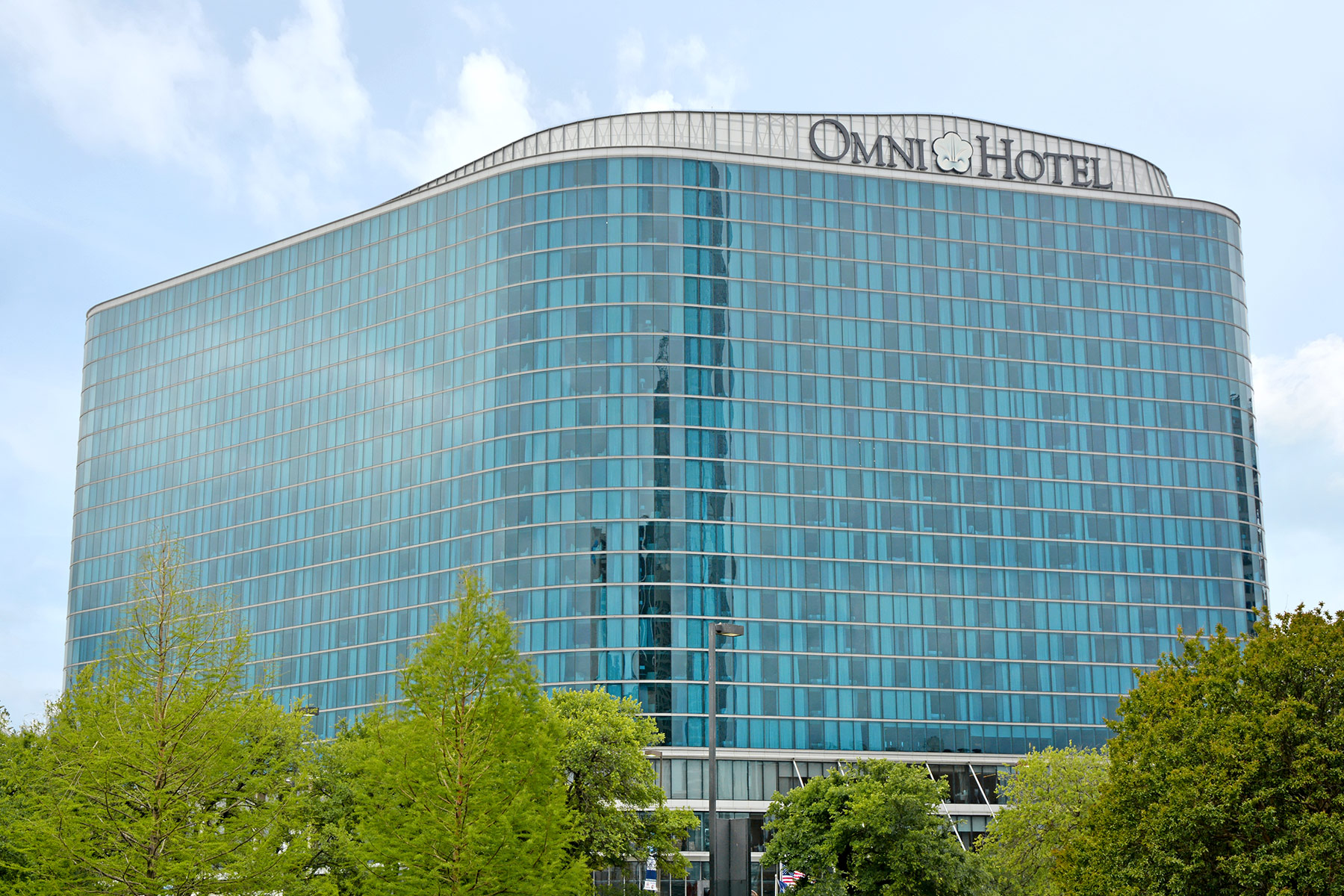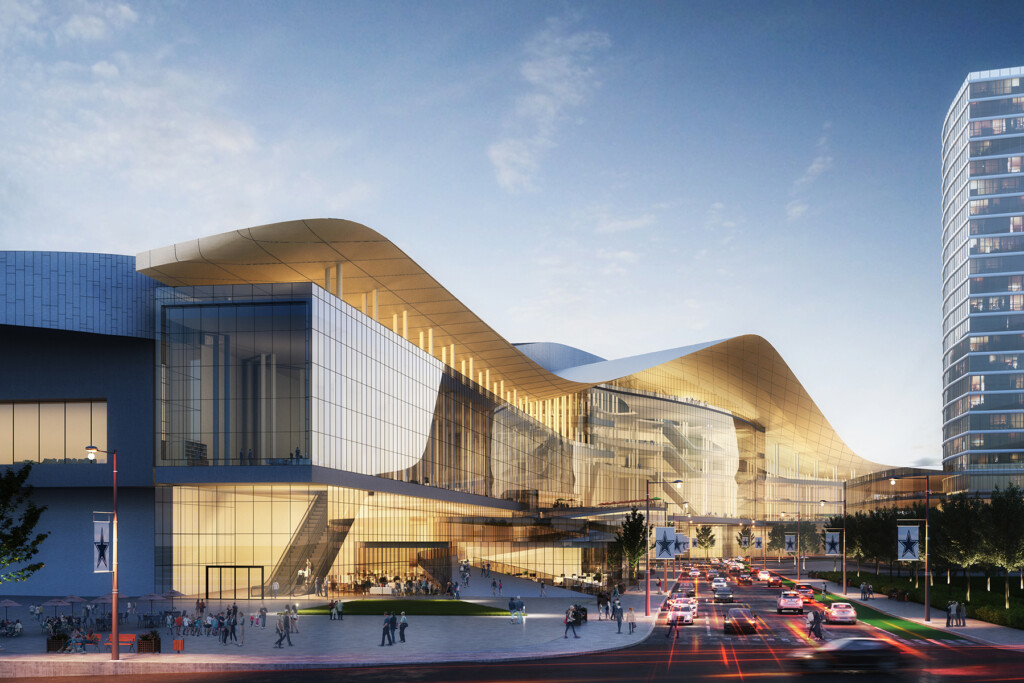By 2029, the city of Dallas expects to have a new convention center in the southern corner of downtown. It’s currently estimated to be a $3 billion project, which uses funding mechanisms designed by the city and the state to make people who don’t live in Dallas pay for it. (That number is likely to change; over the course of the planning process, it has ranged from $2 billion to $4.4 billion.)
Voters last year approved a 2 cent hike on the hotel occupancy tax, and in 2021 the City Council defined a circle around the convention center with a 3-mile radius that will divert hotel, alcohol, and sales tax to the project over the next 30 years. The Texas Legislature cleared the way for both of those elements, so long as proceeds are used for a project like a convention center.
The city unveiled the master plan for the convention center last week, which highlighted interesting things about how modern Dallas develops. Like the highways that touch downtown and shoot to points beyond, this city remains tied to its past decisions. Infrastructure ages, and then we figure out how to retain and improve its existing purpose while trying to fix the problems it caused.
Klyde Warren Park is a good example. It’s decked over the below-grade Woodall Rodgers Freeway, which the state had planned to build elevated. Former Mayor Robert Folsom and City Manager George Schrader stopped the state’s construction and insisted that the highway run in a trench. That’s why we were able to build the park, which is now an important connector between downtown and Uptown. (There was still harm: about 200 homes had to be bulldozed to make way for that freeway, many of which, as my colleague Zac Crain reported a couple years ago, were occupied by Black renters.)
The Texas Department of Transportation wants to narrow interstates 30 and 35 and IH-345, and provide infrastructure for parks and other buildings on top of them. Traffic still flows below.
There are parallels with the convention center.
Its current state is a raggedy Frankenstein’s monster. It is five different buildings with five different sets of roofs and escalators and elevators and other systems. There is $700 million of deferred maintenance, says Craig Davis, the president of Visit Dallas, the city’s convention and visitor’s bureau. Lamar and Griffin streets shoot under it, which make you feel like you’re in a tunnel. There are enormous stretches of unused concrete plazas surrounding the building. It’s piecemeal urban planning, and it’s in the heart of our downtown.
The city’s master plan for the new convention center recognizes these defects and tries to open it up to public space, improving street connections with the Cedars and South Dallas. You won’t have to travel under the behemoth as you head south. The DART rail won’t be in the dark; the city plans to create a transportation hub nearby that will include a confluence of public transit connections. It will have a clear “front door” to orient visitors, something missing from the present complex. And, yes, the city wants to put a deck park over Interstate 30 next to the convention center.
“I think this is much more than a convention center,” Davis said in a phone call last week. “This is the development of a brand-new neighborhood. If we get this right, we’re going to finally bridge downtown with southern Dallas in a meaningful way.”

The master plan frees up 30 acres of developable land, which can be used for residential and commercial space. The city’s presentation showed renderings of dozens of digital humans popping between bars and restaurants, with the convention center in the distance.
The city plans to redesign the streets around the convention center into thoroughfares that can accommodate pedestrians and cyclists. There is also a planned transit network that would include an extension of the streetcar from Oak Cliff. Ghassan “Gus” Khankarli, the director of the city’s Transportation Department, told the Council that plans for the streetcar extension would restart now that the master plan for the convention center is complete.
The convention center itself will have more than double its current meeting room space, which Davis says was integral to attracting the large conventions the city has failed to lure in previous years. The total will be 800,000 square feet of exhibit space and 460,000 square feet of meeting room space. (The current convention center has 725,000 square feet of exhibit space but just 160,000 for meetings.) There are two ballrooms—one at 65,000 square feet and the other at 105,000—and a rooftop event space.
He says 22 conferences have already signed deals for 2030 and beyond, just on the promise of the new-build convention center. The city estimates $630 million in spending from those conventions alone.
Dallas isn’t the only city going all-in on its convention center. Seattle last week opened its $2 billion, 14-story complex with just under 600,000 square feet of event and meeting space. Fort Worth is also moving forward with an expansion of its convention center, which is expected to cost about $700 million.
Convention business is baked into the finances of most large cities. It prompts elected officials to build new hotels and inhales public dollars as cities compete for conventions that bring thousands of people. But convention business ebbs and flows, a reaction to the economy and other factors—like the pandemic—that slow travel and interest.
In 2017, D CEO reported that the Center for Exhibition Industry Research in Dallas showed moderate growth after a difficult 2016. “While business has bounced back, attendance is still not as strong as a decade ago, and convention center supply continues to outstrip demand,” Steve Kaskovich reported then.
Convention business is still rebounding from the pandemic. CEIR’s research found that the second quarter of 2022 was about 25 percent below business in 2019, which was an improvement from the 37.9 percent drop it saw in the first quarter. In the third quarter of last year—the most recent available—convention business was still down 22.9 percent.

Boosters believe convention demand is relatively inelastic and a safe bet for cities—after all, they’re kind of in the same boat, clawing for large companies that want to stuff meeting and hotel rooms with their employees.
“I am not worried,” Davis said. “We can see that the demand for meetings business in the city of Dallas is back if not surpassing our highest times. Now, with the new convention center, our lead volume has gone up, and the size of our leads have gone up dramatically as well.”
University of Texas at San Antonio professor Heywood Sanders has been the most outspoken critic of this model of public investment. In his book Convention Center Follies, he argues that cities are wooed by overly rosy financial reports that lead to further investment in hotels and expansions that often aren’t worth the money it takes to build them. (Dallas built the Omni to add hotel rooms for convention visitors.)
“This is a perverse world where market realities do not affect city decision-making,” he told the New York Times in late 2020.
He also recently suggested to Axios’ Michael J. Mooney that the next metric to watch is attendance: the Consumer Electronics Show in Las Vegas was down about a quarter of its 170,000 attendance in early 2020 and a radiologist convention in 2021 brought just half of the 40,000 it typically attracted.
“I hear what Dr. Sanders is saying, but instinctively Dallas should be competing with every other city for its share of investment,” Davis said. “If we decided to tear down our convention center, we’d be forgoing billions of dollars worth of jobs and revenue and taxes.”
But what about the people who live here? The master plan incorporates public space that is freed up by reconfiguring the existing facility. It includes improvements for both the Black Academy of Arts and Letters and the George Dahl-designed Dallas Memorial Auditorium, which the city said it plans to use to target e-sports and concerts.
Nearby landowners such as Ray Washburne, who owns the old Dallas Morning News building near Union Station, appear eager to open up developments to the new convention center district. (Others include Jack Matthews in the Cedars and Ray Hunt near Hunt Realty Investments’ Reunion Tower and the adjacent Hyatt Regency.)
The planning discussions regarding the land upon which the convention center sits always included the convention center. Just like the land upon which the highways sit always include highways. Our public officials believe downtown will be better with the new convention center, just as they believe the areas around these highways will be improved. That is hard to argue with, but it’s also worth thinking about what could exist without them. Maybe, even, we could learn from those possibilities.
But we’re still planning for the future with the infrastructure of our past. In the case of the convention center, we’re betting on consistent revenue from tourists and conventioneers. Davis is bullish, and the city showed Council figures that it said proved that tourism dollars were higher last year than they were in 2019. (It is important to note that those figures weren’t just convention dollars.)
Could this land be used for other things? Sure! But the city and state have prioritized the convention center by limiting how the city can spend its hotel tax. Now we need to hope this master plan considers the people who live here—just as it considers those who don’t.
A shorter version of this story first ran in D Brief, D’s free Sunday newsletter. You can subscribe here.
Get the D Brief Newsletter
Author





